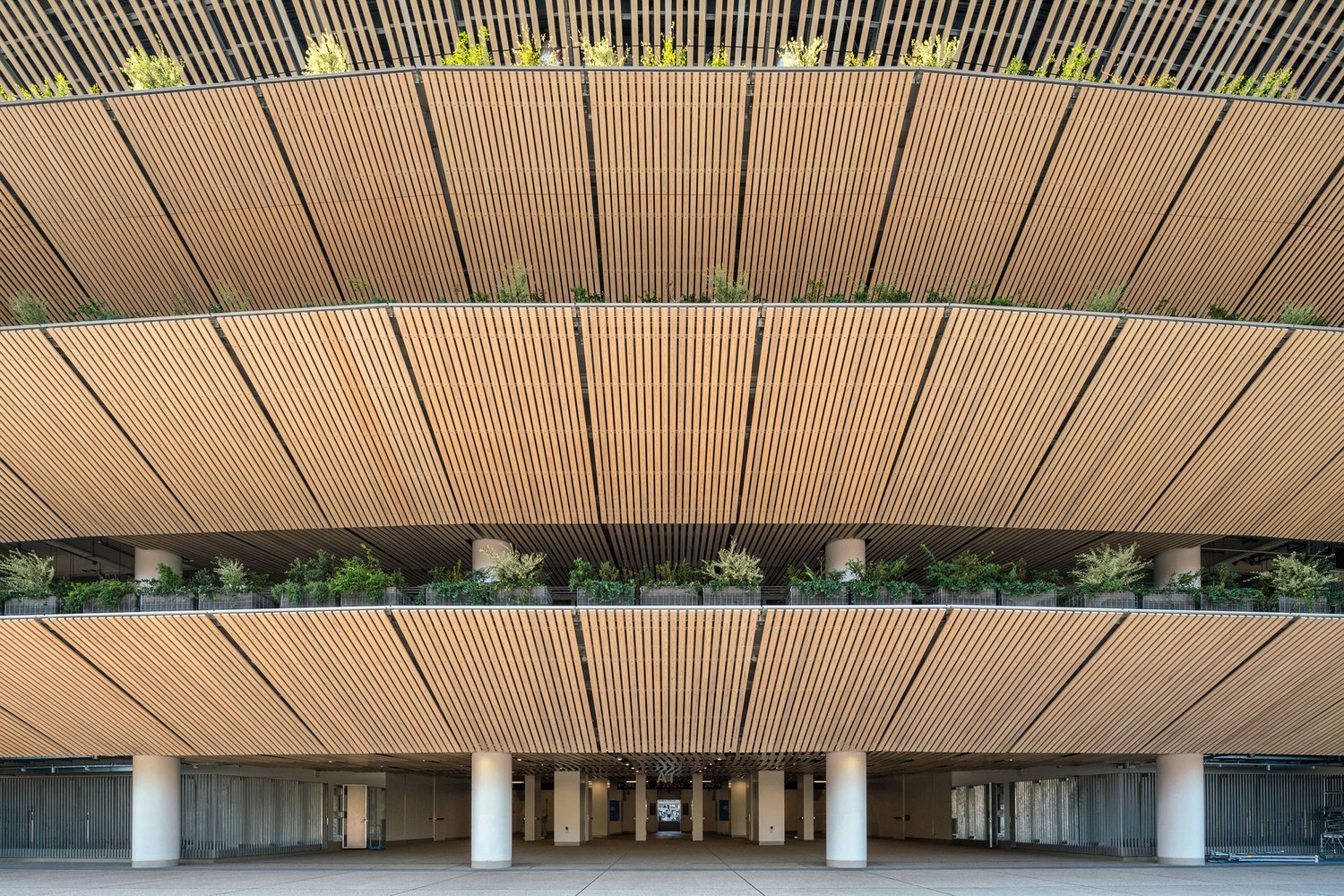
Nature
The addition of planting and nature can soften a stadiums appearance, helping it blend into its surrounds and even act as a calming presence. We look at some of the global examples leading the way.
The Oval Cricket Ground, set in and around a series of densely populated terraced streets in London, is a successful example of the use of biophilic design with the addition of a verdant green wall growing up the exterior façade.
The façade of the Japan National Stadium follows a similar approach through a ‘living tree concept’ which wraps the stadium in overlapping multi-layered eaves. The underside of each eave is covered with wooden louvres, echoing the tradition of crafted eaves in Japanese architecture. In Munich a new 11,500-seat arena that hosts the city’s basketball and ice hockey teams has been designed to merge into the landscape of the Munich Olympic Park, with a green roof covering the oval structure.
Image: The Oval Cricket Ground, London
The proposed (but not commissioned) International Forest Stadium, which would be home to both AC and Inter Milan, seeks to take the relationship between nature and stadiums a step further. Set in the heart of a 4.5-hectare public urban park, the project makes nature the protagonist of the football experience, introducing a new urban landscape for all citizens25. The stadium design includes 5,700m2 of horizontal green roofs and 7,000m2 of green façades. Together with a total of 3,300 trees and 56,300 shrubs of 70 different species, the design is expected to absorb 162 tonnes of CO2 annually.
A stadium design which has been commissioned and is in the making Is the ‘Arena of the Forest’, the future 26,000-seat stadium which will be home to the Danish Superliga team AGF (Aarhus Gymnastikforening). Nestled within the city’s 1,400-acre Marselisborg Forest, the single-tiered stadium has been designed to sit comfortably within its unique context, with the design of the façade responding to the vertical rhythm of the surrounding trees.
Image: ‘Arena of the Forest’, Aarhus, Denmark
The City of Aarhus has a goal of a carbon-neutral society by 203028, and the ‘Arena of the Forest’ responds to this city-wide ambition with the design and construction of the new stadium being driven by the recycling and re-use of the materials and components of AGF’s previous stadium29. The vision of the project is for the stadium to be a “new landmark for the city that incorporates the highest standards of environmental, economic and social sustainability within every aspect of its design and construction.”
Over the coming years in the UK the relationship between stadium developments and nature will grow in importance with the introduction of BNG (Biodiversity net gain) by the UK Government. The new mandatory development policy aims to make sure that habitats are left in a meassurably better state than they were before development by ensuring projects deliver a BNG uplift of 10%.
English Championship team Oxford United have submitted a planning application for a brand new all-electric and nature-positive stadium, the first of its kind in the UK31. The site is undergoing a detailed bio-diversity net gain analysis to ensure it helps to enhance local woodlands. The project is aspiring to achieve a 20% BNG which is in line with targets in the local area.
Image: Proposed International Forest Stadium, Milan
Image: Stadion Galgenwaard, Utrecht, Netherlands
In the Netherlands the city municipality of Utrecht has worked in partnership with the owners of Stadion Galgenwaard, home to FC Utrecht, and the owners of an adjacent office tower to plan for the renewal of the area around the stadium. The ambition of the project is for the area to become a place where Utrecht residents would come to live, to play sports, to work or to watch an FC Utrecht match.
The public realm surrounding Stadion Galgenwaard is predominantly concrete which leads to temperatures on a hot day being 7 degrees higher than in surrounding green areas. With this in mind the project is seeking to introduce a park concept around the stadium to make for a more liveable and enjoyable place and to knit the area into its surrounding green context. In addition the municipality of Utrecht is working with FC Utrecht to increase the volume of fans that can access the stadium via bicycle on matchday.
Image: Olympic Park, Munich
More from Sport+
Sport+ Nature
We look at some of the best global examples where nature has been used to embrace sports stadiums.
Sport+ Community
We spoke to Glen Sutton from Fulham FC to find out about the placemaking led approach to the re-development of their Riverside Stand at the historic Craven Cottage.
Sport+ Sustainability
The Johnan Cruijff ArenA in Amsterdam, home to Ajax FC, has pioneered an innovative new approach to generating energy within the stadium.








